Owen K.C. Stephens's Blog, page 19
September 6, 2022
#SettingPitch: Dwarf Planets, Dwarf Gods
Just a quick idea for a scifi-horror or urban modern fantasy campaign.
DWARF PLANETS, DWARF GODS
Each planet is a god… but only as long as they are revered as planets. Pluto was the gatekeeper of the realms of the dead. Its power was vast, but focused entirely on keeping the vile undying of the extrasolar void away from the worlds of light.
Now? Now Pluto is only a dwarf planet, and thus only a dwarf god. The civilizations of Earth have noticed as things get worse and worse, but don’t understand why. Small vile things from the cosmic true vacuum have been slipping past, and people are affected. But that was just the first cracks. Years have past. Pluto is tiring.
It’s about to get much, much worse. And much, much more obviously supernatural.
The mummies of Mars are rising. The vampiric tombs crawling along Mercury’s dayside are slowing, inching closer to the darkness that can awaken them. The ghoul spores of the world that became the asteroid belt are stirring. The angry Red Specter of Jupiter is awakening, and preparing to burst forth from his cyclonic cage.
The other god planets are preparing to do what they can. To empower people, organizations, and creatures to defend against the growing threat. But each god planet is already has its full attention and power dedicated to other concerns. Jupiter can spare little attention for the Red Specter, else the infernal comets it deflects from life-bearing worlds will smash into the inner system. Saturn’s rings must kept the ecliptic harmonic in balance, lest the constants of the current universe vary.
The god planets will help where they can, but it is humanity that demoted Pluto. It is humanity that must bear the brunt of the consequences.
Support My Patreon
The more support I get, the more time I can spend on writing things like this.
If you enjoy any of my articles, please sign up, for as little as the cost of one cup of coffee a month!
September 5, 2022
Drafting Alternate Grenade Rules (With An Example For Starfinder)
Grenades, and explosives in general, are tricky to write rules for in most d20-based ttRPGs. If a grenade isn’t effective enough, it feels more like a firecracker than a deadly weapon of war. If it’s too effective, it can end encounters so quickly it’s no fun for the players, or accidentally wipe out PCs in undramatic ways.
When grenades show up in action/adventure fiction, they tend to act less as damaging devices than plot devices that force people to seek cover. The threat of them is generally represented not by them killing main characters, but by forcing characters to take them seriously and possible shake off effects of shock and awe.
 (Grenade art from the public domain)
(Grenade art from the public domain)Example: Starfinder Revised Grenades
So, let’s try to model that behavior, specifically for Starfinder. Within that game, grenades are pretty expensive consumables anyway, so a power-up shouldn’t break the game even if it makes grenades more affective and appealing. That said, if these seem too powerful, you can limit these rules to actual purchased consumables, rather than spells and class features that allow characters to create or emulate grenades without a credit or OPB cost.
Grenades
Grenades are dangerous, deadly military explosives that everyone must take seriously as a threat, no matter how tough or resilient they are. While savvy and active combatants know to duck for cover and shake themselves free of the shock of battlefield explosions, doing so comes at a cost.
When you fail a saving throw against a grenade that has an item level no lower than your character level/CR -2 that deals damage (as opposed to, for example, smoke grenades), you must either expend a Resolve Point or be staggered on your next turn. This represents the need to duck, take cover, and shake yourself back to focus after narrowly avoiding more serious injury.
Helpless characters that fail a save against such a grenade treat the attack as a coup de grace against them. As a full round action a character can make an Engineering check (DC 15 + 1.5x grenade item level) to wedge a grenade into an adjacent stationary structure or unattended object, causing it to do max damage and have only half its normal explode radius. On a failed check, the grenade explodes in the character’s hands, and they take max damage.
Patreon
I have a Patreon. It helps me carve out the time needed to create these blog posts, and is a great way to let me know what kind of content you enjoy. If you’d like to see more Starfinder content (or more rules for other game systems, fiction, game industry essays, game design articles, worldbuilding tips, whatever!), try joining for just a few bucks and month and letting me know!
August 31, 2022
ShadowFinder Supporting Players
We’re coming up on a year I have been working on ShadowFinder, though not with the regularity I’d like. Because I have big way-behind projects after carving out a period of time to try to “finish” it (which, for various reasons didn’t do anything like get it finished), I’ve pretty much been restricted to jotting down notes when ideas come to me, and sneaking in some work on the project as blog posts (since I have blog subscribers who have already paid me for this content, so I’m obligated to keep doing this along with the other projects I am obligated to do, as opposed to ShadowFinder which is entirely optional).
But even slow and sporadic progress is progress. And today, I’m sharing some conceptual material I wrote early on in the process. I wanted to think about the types of characters I would want to be able to have as supporting players (and, perhaps, PCs). Things like this are among my guiding ideas when I work on a game setting or expansion — conceptually what do I want to be able to make with these rules and any advice that comes with them?
Earlton and Alyssal
Earlton Fust is an old, old zombie. He cannot see, smell, feel, or taste, and his hearing is weak. But for all that he is slow and clumsy, he possesses vast strength and resilience.
Alyssal Rein is a very recent ghost. Though she cannot be wounded, moments that would have harmed her living self still cause her to flee into the umbra. In fact, she can barely affect the physical world, her powers largely limited to her senses, speaking to the dead, and the ability to possess corpses.
Corpses like Earlton Fust.
She can literally become his eyes and ears, feeding him her senses, animating his flesh to be swift and nimble. In turn, his flesh can impact the mortal world in ways she cannot, his tongue speak words she wishes spoken. It is a strange arrangement, two dead souls operating in the world of the living, but they both appreciate its benefits.
Earlton was a private detective a century ago. Alyssal was murdered by an unknown foe a year ago.
They fight crime.
[I see Earlton as a specific build for a mechanic character with the exocortex option, except the “exocortex” is the ghost Alyssal. That leads to needing rules about mechanics that are magic-based rather than technology-based, which can then also be used for magical girls, ring wielders, and maybe lycanthropes. Which begins to sound like an alternate class, which is fine, I have technicians for most of what mechanics do with tech, and with a few tweaks the mechanic drone option can become a pet class that summons a spirit to fight for them, like an eidolon…]
The Sleepwalker
Michar Micharland, known in some circles as The Sleepwalker, knows the real world is one free of magic and monsters. So, despite his memories, he rejects the idea that he was hit by a bus, killed, and brought back to life with eldritch powers.
Well, he thinks the bus part probably happened.
Which means if he’s not dead (and this seems too weird to be either heaven or hell) then he must be in a coma, and everything he is experiencing is just his brain firing off random neurons to keep itself amused until he wakes. If he wakes.
So, he has no fear. No concern. He believes to his core that everyone he meets is just part of his coma-induced dreams. None of it is real. Nothing can actually damage him, even if he feels pain. (Flashes of the pain from the bus impact leaking into his subconscious, maybe). He believes he’s walking through an imaginary world where none of his actions have consequences.
So, he helps as many people as he can. Because that’s his idea of a fulfilling dream. Doing anything else would make him feel like an ass.
[The Sleepwalker could be a mystic with a connection to dreams, or a warlock using my new warlock class. But he also needs something that lets him lean on his belief system, even if it’s wrong, to overcome things like pain and fear. That sounds a lot like a feat or archetype which could then be used for people with strong religious convictions, or the ability to fall back on scientific rigor, or who think they are the Chosen One.]
Patreon
I have a Patreon. It helps me carve out the time needed to create these blog posts, and is a great way to let me know what kind of content you enjoy. If you’d like to see more Starfinder or ShadowFinder content (or more rules for other game systems, fiction, game industry essays, game design articles, worldbuilding tips, whatever!), try joining for just a few bucks and month and letting me know!
August 30, 2022
The Greatest Game Mechanic In The World … Tribute.
Last night, gripped by exhaustion and insomnia, unable to stay up or lie quietly, with half my body burning up and the other half freezing cold, I had an amazing idea for a game mechanic. I wasn’t awake enough to go write it up, so I tried to take some notes about it, to make sure I didn’t lose this amazing idea for ever.
…
Sadly, the notes are literally useless, and while I remember thinking about the idea — every aspect of where I was when I had it, what time it was (3:45 am), and how much I tried to burn it into my brain so I would not forget it… the idea itself is gone. A complete blank. other than knowing it has to do with ttRPGs, I have no clue what it was like.
So, in tribute to that Greatest Game Mechanic in the World, which is gone forever, here is an entirely different RPG mechanic ideas, which is NOT the Greatest Game Mechanic in the World and may, in fact, be bad.
Blurred Positioning
Most ttRPGs have some form of segmented movement, where on a character’s turn they take an action or set of actions (such as “move, draw a weapon, attack”), and then the next character takes their actions, and so on. This causes the problem that it is difficult to represent actions interrupting other actions in the natural flow of an encounter. All too often, someone either runs from point of cover to point of cover with no one having any change to shoot at them unless they have stood around waiting for just that (and let’s be honest, if someone is dashing 20-40 feet, there’s at least a chance that someone with a firearm could pop off a round at them), or is behind cover and wants to pop up, fire once, and duck behind cover, is stuck for a full round standing exposed and away from cover because they couldn’t complete the action before the end of their round. Instead of some cover, they have no cover for everyone else’s turn.
Blurred positioning accepts that even if your character is in a given place at the end of their turn, someone might have taken an action in a rush as they repositioned. At the end of a character’s turn, they state one of those positions to be their “main state” even if it’s not the one they ended at. (You may have ended standing up from cover at the end of your turn, but you spent most time ducked behind it on your round).
Each character is a legal target at every place they have been since their last turn. However, actions taken actions a position other than their end-state suffer a penalty (-4 or -20% or roll twice and take the worst result, depending on your game system).
That’s it, that’s the whole mechanic. Wherever you were at any point on your last turn, you can be targeted as if you were there. But, for al but one of those places, people are at penalties for trying to get you at that exact moment.
…
No, seriously, the idea I had last night was SO good.
Whatever it was.
Want to Help Me Create?
I have a Patreon. Please consider joining it so I can keep writing stuff.
August 29, 2022
AI Images as References for Live Artists
So, I’ve written a few articles on my exploration of human-prompted, AI-generated images. There is going to be more and more public discussion about this, and I think articles like this one at Kotaku, are important to read and consider. Of course, such articles are generally an undifferentiated mix of fact and opinion, but even where I disagree with the opinions I want to be open to them and see if any new points of view or data are presented that may alter my current position on the issues.
I also want to keep exploring various possible ways to use human-prompted, AI-generated images. One of the things I’ve mentioned is the idea of using such an image as a visual reference for an artist.
So, I did.
Here is an image of a lich I got from prompts fed into MidJounrey.
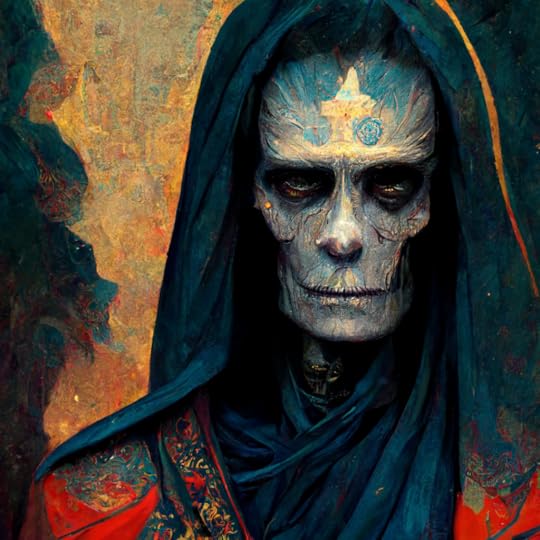 (Generated from prompts I fed into MidJourney)
(Generated from prompts I fed into MidJourney)I really like this image, including it’s sartorial style, but there are (at least currently) significant limitations I’d have to contend with if I wanted to use this commercially. Not the least of those is I have no way of creating different images of the same being.
So, what if I gave this as a reference to an artist I like? (And, you know, pay them to create more art.)
So, I took this to Jacob Blackmon and asked if he was willing to participate in my experiment (at his standard rate). He was, and sent me this sketch:
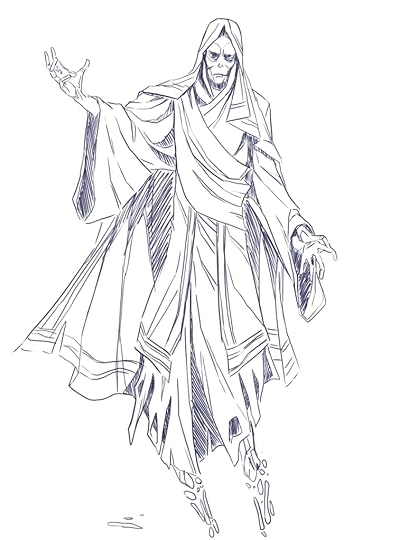 (Art by Jacob Blackmon, a living professional artist and great person.)
(Art by Jacob Blackmon, a living professional artist and great person.) This highlights two of the things I love about working with Jacob. First, he did a LOT of design work in this piece, flowing from the reference image, but absolutely building well beyond either it or even standard fantasy lich images. Secondly, his sketch stage has enough detail for me to see where he is going and give useful feedback or ask for alterations. In this case, I gave an immediate thumb’s up.
So, that brought us to this, Jacob’s final.
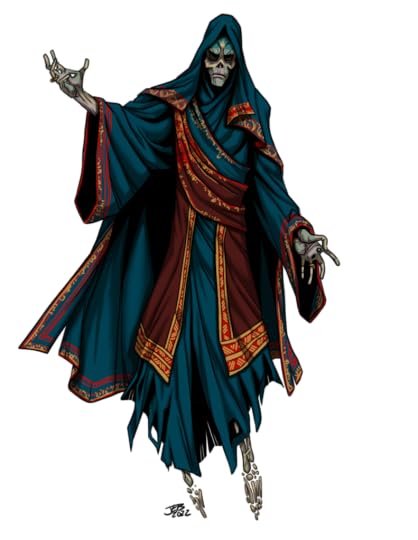 (Yep, also by Jacob Blackmon)
(Yep, also by Jacob Blackmon)This is awesome, it shows Jacob distinct and developing style, I love it, i can use it, Jacob got paid for it, and it would not have existed without MidJourney returning the top image in response to prompts I gave it. It’s not a duplicate of the original (nor did I ask for it to be), but it clearly uses that image as the umping off point for a new design.
I like this result, and can easily see going this route again. It remains to be seen how issues of legality, ethics, and public opinion shake out on any use of human-prompted, AI-generated images, but I found this a useful project to help me explore my own thoughts on the subject.
And, in this case, it put money in the pockets of an artist I like, which is always a plus.
Speaking Of Money…
I have a Patreon. It helps me carve out the time needed to create these blog posts, and is a great way to let me know what kind of content you enjoy. If you’d like to see more essays on industry issues, or Pathfinder 1st or 2nd edition, 5e, or Starfinder content (or more rules for other game systems, fiction, storytime posts, game design articles, worldbuilding tips, whatever!), try joining for just a few bucks and month and letting me know!
If you prefer, you can drop a cup of support in my Ko-Fi. It’s like buying me a cup of coffee, but more convenient!
August 26, 2022
#MoviePitch: Villanus
Nobody ever pays much attention to Slammer, Oklahoma. Sure, it’s weird that there’s one Big House where the mayor lives, and everyone else is in tiny cabins and do farm work. And yeah, now that you mention it it’s odd that so many of the residents are cyborgs, floating brains, talking wombats, and the floating brains of talking wombat cyborgs.
But, it’s not like the whole town is populated by nothing but paroled super-villains, living under the watchful eye of the God of Dungeons just so they can live some semblance of a normal life, right?
…
Right?
And when tornadoes tear and flooding through Slammer and all the surrounding counties, taking out the God of Dungeons and doing a ton of damage and putting lives at risk, how are the ex-villains going to react to the combination of sudden unmonitored freedom, and a massive natural disaster?
Help?
Rob a bank?
STEAL a bank?
All of the above? …
August 24, 2022
AI Art As Writing Prompts
So, I generated this image using MidJourney.
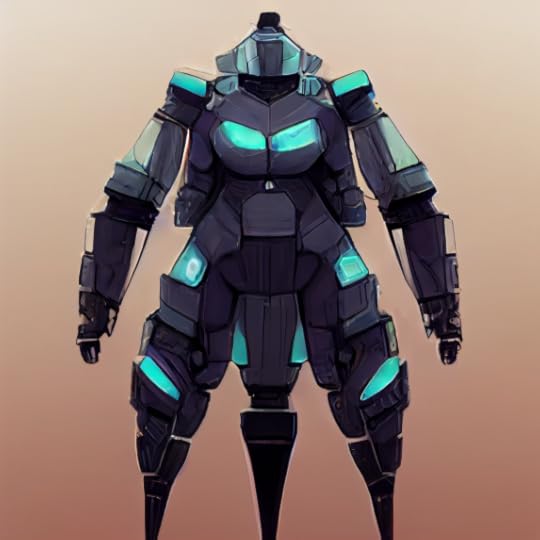 (Created by me using MidJourney)
(Created by me using MidJourney)That image is at least as good as many I have seen in ttRPG gear books, and would make a great tripod security robot, or battle armor for a 3-legged species, or mecha for someone who pilots it from a chest cockpit.
But none of those things were what I was going for. Moreover, at least at current iterations, AI image generators can’t give me that same figure mixed with others, or in a different position, or holding a different gun. If I want any of that, I am much better off paying a living artist. So I expect living artists to be a crucial part of my business needs for the foreseeable future.
Right now, I’d say 80% of the useable art I get isn’t exactly what I asked for, or is background without characters. Other people are doing better, but I can only analyze where I am.
Which means a lot of these images end up being writing prompts if I want to use them in a commercial product. I have the skill to do that, and in one sense it meets my needs — if I set out to create a product I can generate images to build the game material or fiction off of until i have all I need, then write to the images. But I can also already do that with stock art. The upside of stock art is that it’s often easier to get things in the same system, there is an original artist I can go to commission variations if I end up needing them, and a copyright definitely exists (though not, for example, for public domain stock art). The advantages of the AI prompt are that it won’t have been overused before I release my product with it, and it may be cheaper. But it also may not be subject to copyright (see my last article on this subject), which would mean once it was out, anyone could reuse it. Again, much like stock art.
And, of course, I could use the AI generated images as writing prompts, then pay an artist to create new images using the AI image as a reference, which is going to have a mix of pros and cons that won’t be clear until case law is better settled, but it certainly less risky than pure AI images.
If I decide to use AI images for commercial products, I strongly suspect they’ll mostly end up being used for the same sorts of purposes as stock and public domain art. I haven’t taken that plunge yet, and may never do so, but I can see how these would become one more tool. I can’t see how they could replace all the artists I regularly give money to, even if I wanted to do so.
(This is an editorial. No part of this article is covered by the OGL.)
Speaking Of Money…
I have a Patreon. It helps me carve out the time needed to create these blog posts, and is a great way to let me know what kind of content you enjoy. If you’d like to see more essays on industry issues, or Pathfinder 1st or 2nd edition, 5e, or Starfinder content (or more rules for other game systems, fiction, storytime posts, game design articles, worldbuilding tips, whatever!), try joining for just a few bucks and month and letting me know!
If you prefer, you can drop a cup of support in my Ko-Fi. It’s like buying me a cup of coffee, but more convenient!
August 23, 2022
One D&D: What Can “Compatible” Mean?
This is an editorial. It is not covered by the Open Gaming License.
One of the things that’s being debated in the wake of the “One D&D” playtest release is how this is going to impact D&D customers, other publishers making compatible products, Virtual Tabletops (VTTs), and the ttRPG environment overall. For better or worse, D&D has a huge influence on tabletop RPGs overall in the English-speaking world. Even if you don’t play D&D, and never have, it’s popularity can impact what dice, maps, digital tools, play spaces, game conventions, and dozens of other adjacent materials and options are available to you.
There have been sea-changes in what was considered “D&D” several times before. The release of AD&D in the late 1970s was one, and to some extent so were both BECMI and 2nd edition AD&D. The release of 3rd edition in 2000, which dropped the “advanced” in the title, along with the introduction of the d20 System and OGL had a huge impact in 2000, and the release of edition “3.5” in 2003 is seen as going hand-in-hand with the “d20 crash,” leaving a lot of companies who used the OGL in trouble. (Indeed, many ceased to exist, and others walked away from d20 System-derived games forever.) Similarly the release of the radically different D&D 4th edition in 2008, which abandoned the OGL, had significant impacts throughout the industry (not the least of which was the creation of the circumstances that lead to Pathfinder 1st edition, and by extension eventually Starfinder and Pathfinder 2nd edition).
With the exception of the switch from 3.0 to 3.5, these changes didn’t much revolve around claims that the new D&D would be compatible with older editions. The release of 5e in 2014 was a bit different, often centered on the idea that it was going to take the best ideas from all previous editions, but it also tied to efforts to be simpler and more accessible, and to have “bounded accuracy” fix many of the problems in mid- and high-level play.
One of the talking points of One D&D is that this isn’t a “new edition,” but a modification of the once-and-future D&D engine that is the core of 5e. It is, we are told, going to be compatible with existing D&D materials.
So, in this instance, what does “compatible” mean? And, what’s WotC’s goal in striving for their new rulebooks (I’m entirely convinced there will be new print PHB, DMG, and MM books, and that belief serves as one of the underpinnings of this analysis) to be in some way compatible with the material they have been putting out since 2014?
Well, firstly, I don’t expect WotC to be particularly concerned about how their decisions impact people making “5e Compatible” products, and I don’t think it’s realistic (or, honestly) reasonable for anyone else to expect that either. The only group that might feel they have some claim on WotC’s mindspace is Dungeon Master’s Guild publishers, since they are working within the WotC IP, in a space where WotC gets a cut of their income. But even then, I personally expect WotC to do what they think is best for their own company (and will thus be most likely to allow them to continue to be the best-paying ttRPG employer in North America, and maybe the world).
My best guess is that WotC is going for One D&D to be “100% Adventure Compatible.” And, in this, I may be letting myself be influenced by the fact that’s very similar to what I was shooting for in the Fantasy Age Core Rulebook, which I have been saying since its inception was not a “new edition,” but a “quality of life improvement implementing much of what we have learned since Fantasy Age Basic Rulebook came out.”
While working on that, I discovered that you can make a new rulebook be “100% “compatible” with all the old accessories and adventures, and still not be exactly the same game. You can, with skill and caution, make a game with some new mechanics, and some mechanics that work differently, and not create anything that doesn’t work with the old game mechanics.
Let me give you a concrete, and entirely theoretical, example.
Let’s say you had S.T.A.B. (Sneaking, Talking, Arcana, and Battle) 1st edition, a very d20 System-esque game, where the success of most tasks are determined by rolling a d20, and adding some modifiers, and trying to hit or beat a target number. If you d20 die roll is a natural 20 you automatically succeed, and if it’s a natural 1, you automatically fail. And, one of the persistent pieces of feedback you get, is that people hate Hate HATE rolling a 2 on their d20 roll, because they will always fail due to the game math, even though it’s not an “automatic failure.”
So, when you release S.T.A.B.B.E.D. (Sneaking, Talking, Arcana, Bards, Battle, Economics, and Dragons), an “updated rulebook for S.T.A.B., you add a new rule — anytime your d20 roll is a natural 2, you then roll 1d10 and add it to your total. If you roll a 3 you add 1d8, if you roll a 4 you add 1d6, and if you roll a 5 you add 1d4. (This is almost certainly a terrible rule, I’m using it just as a very basic illustration of “compatible-but-not-the-same’).
Now, this changes the math of the game, and impacts how the game plays in many significant ways. Someone playing with the S.T.A.B.B.E.D. book is going to have a very different experience than with the S.T.A.B. book, and you can’t really have some players use one and some use the other. But you CAN use *either* to play through the classic adventure “King of the Demonpit Webs.” And they both work with the official expansion Stabinomicon book of extra classes, ancestries, spells, and talents.
But if a third-part publisher had released BASH (“Basic Adventure System Handbook”), based on STAB, and in BASH there was a whole system for earning a “booster die,” which you added to d20 rolls, and additional rules written with notes such as “If either your d20 die, or any die you get to add to it, is a 1, you take a point of Dangit, which the GM can use to cause you bad luck,” then the BASH system suddenly isn’t nearly as compatible with STABBED as it was with STAB.
Now, that example is clearly and intentionally ridiculous. But it shows how a new rulebook can have a set of notably different game rules that still work with all the official expansion books a company has released. It is, in that regard, “compatible.” And for people who only but official STABBED books, it doesn’t matter if they play older adventures or newer “Hardship paths,” though old STAB books, and anything other publishers build off STAB, may not work with all the new material.
While obviously I don’t have any insider insight into exactly what WotC is planning beyond what they have publicly stated, I have done this kind of backwards-compatible new game book work myself. It can be done. And it’s compatible.
Just not the same.
And Now, A Call To Action!
I have a Patreon. It helps me carve out the time needed to create these blog posts, and is a great way to let me know what kind of content you enjoy. If you’d like to see more essays on industry issues, or Pathfinder 1st or 2nd edition, 5e, or Starfinder content (or more rules for other game systems, fiction, storytime posts, game design articles, worldbuilding tips, whatever!), try joining for just a few bucks and month and letting me know!
If you prefer, you can drop a cup of support in my Ko-Fi. It’s like buying me a cup of coffee, but more convenient!
August 22, 2022
Savage Worlds: RIFTS: Pawns
So, it’s VERY nice to have friends give you stuff. Having *just* mentioned that I do miniatures on a budget, friends returning from Gen Con gifted me with two sets of modern building props, a bin of Heroclix figures… and a box of Savage Worlds: Rifts: Pawns.
So, I did not get this as a review copy, and I had nothing to do with its creation.
And I don’t currently play Savage Worlds, or RIFTS of any flavor.
And I love this set. It’s going to see SO much use in Starfinder and Mutants & Masterminds games in my house. The visual design has always been one of the things I loved most about RIFTS, and these are some great examples of that. Since I have a ton of Pathfinder pawn bases sitting around I placed my RIFTS pawns in those, and they fit perfectly.
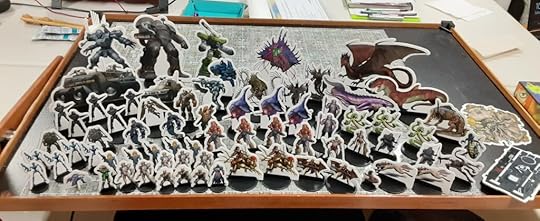
These aren’t *all* the pawns that come in the box, but they are (IMHO) those that work best as Large or bigger figures. They are bright, crisp, and bring a great visual for big monsters, alien creatures, emcha, vehicles, and one cool hoverjet.
The pawns come with little cross-brace stands you can slip them into, as seen on the crouching figure on the lower left. I prefer bases that cover a creature’s footprint, but you CAN use these without separate bases with just what’s in the box, which feels like a great value added feature.
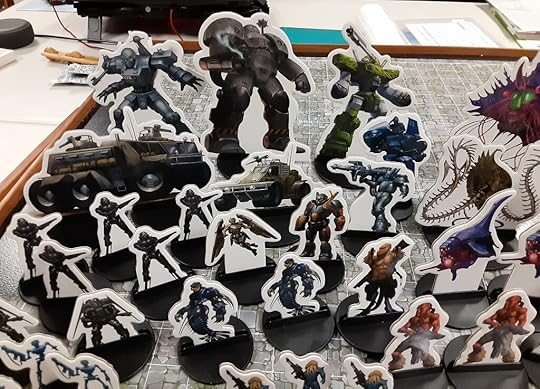
I am particularly impressed with the mecha and upright vehicle pawns, including the Glitterboy. I would HAPPILY buy a box with just more of these.
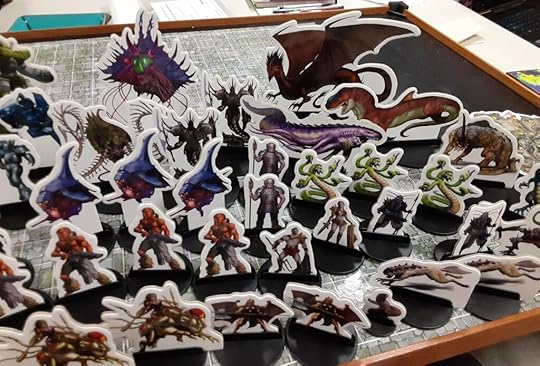
All the pawns have distinct front- and back-art, in case you care about facing. The big wheeled vehicle flat is blank on the bottom, which seems like it’s missing a chance to have a wrecked version if you flip it over, but that’s the only missed opportunity in the set. These are on a 1-inch grid, and most of the bases are 2 inches in diameter (with a single figure on a 1-inch base on the lower right)
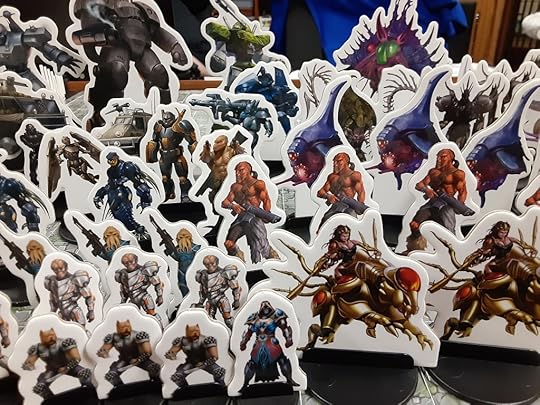
There’s a great mix of straight scifi, weird scifi, and science-fantasy in this set, as you’d expect from RIFTS. There are lost of single characters, but also some useful groups (such as Coalition bots) and Pinnacle Entertainment Group did an amazing job on the selection, art, and quality of production.
I got this set for free, but would happily pay the MSRP for for another set of the same size and quality.
Speaking of Paying For Quality…
I have a Patreon. It helps me carve out the time needed to create these blog posts, and is a great way to let me know what kind of content you enjoy. If you’d like to see more product reviews, or essays on industry issues, or Pathfinder 1st or 2nd edition, 5e, or Starfinder content (or more rules for other game systems, fiction, storytime posts, game design articles, worldbuilding tips, whatever!), try joining for just a few bucks and month and letting me know!
If you prefer, you can drop a cup of support in my Ko-Fi. It’s like buying me a cup of coffee, but more convenient!
August 19, 2022
The Tragic Atheneum. #WelcometotheArmitage
You can find more information about the mysterious Armitage Building on my Facebook and Twitter, under the hashtag #WelcometotheArmitage. Some other folks have joined in under that hashtag, as well. This is one of several longer pieces I started about the building, but have yet to finish or decide what to do with.
The Tragic Atheneum
On the 10th floor of the eclectic Armitage Building, in room 1016, is the Tragic Atheneum. It’s door is marked with “10*1016” in gold paint, and an image of a quill pen. The door is unlocked from 3 am to 11:11 pm, and no force seems able to get past it when it’s not locked. Those waiting for it to open do not note any sound, or see anyone tending to the door. At 2:59:59 am, it is locked. At 3, it is not.
The Atheneum is one of the biggest rooms in the building, decorated in a heavy, overstuffed Victorian Gothic style. The gold leaf crown molding repeats “10*10*16” endlessly, there’s a small counter no one is ever manning near the only apparent door in or out, there’s no sign of any windows, and the interior is filled with a labyrinth of bookcases and cabinets that you can, literally, become lost in. Here, filed in ways no mortal has yet to comprehend and with constantly shifting positions, is every written book, story, and article that could have been, but wasn’t. There is no staff, but the Atheneum is meticulously clean and maintained. A simple ledger sits at the front counter, marked on the cover with the title “Million-Million-Million-Milton-Monkey-Marginalia” has columns for who is checking out a book, what book is checked out, and when it will be returned.
There’s a 1921 World Victory Pen Company ball point inkwell pen by the ledger. It never runs out of ink, and anyone who takes it out of the room loses it, as it always returns to the counter. Nothing else successfully writes in the ledger.
Faded instructions on a small index card notes at the counter all returned books must be placed on the return table, and no book may be borrowed from the return table. Of course, you books are removed by someone from the return table and refiled, and you can’t always find the same book again. A sign warns that return dates must be within 28 days, by 11:11 pm of the last day, and that tardiness is strictly forbidden. No one at the Armitage knows anyone who has ever been late turning a book back in. A few people who used the Atheneum and were habitually late or disorganized have simply disappeared but no one knows for sure if that is related.
Any print media from the Tragic Atheneum that is taken from the Armitage grounds becomes so faded as to be unreadable, though within the Armitage’s lights the print is perfectly clear. Electronic and recording devices do not record words from Atheneum texts, whether typed in, spoken aloud, or photographed. Written copies of such texts fade immediately if removed from the Armitage, and are not restored upon returning, and fade within weeks regardless.
Nonresidents visiting the Armitage seem unable to find room 1016, even if escorted by a resident. They can see and read texts residents have in their rooms, or any of the many cozy reading nooks, lounges, and studies scattered throughout the building, but only retain information gained in a general way, and never remember any twist or noteworthy conclusion. Residents do, but get a general sense it’d be a bad idea to spread that information around.
Sometimes, alternate version of religious texts are found within the Tragic Atheneum, but they are always bound shut by chain cages, and marked with a tag indicating they are not to be checked out. A few have done so anyway. One of those was last seen fleeing from the lost god’s suite on the 72nd floor.
The others have never been seen again.
#WelcometotheArmitage
Want to Help Me Create?
I have a Patreon. Please consider joining it so I can keep writing stuff.
Owen K.C. Stephens's Blog
- Owen K.C. Stephens's profile
- 7 followers



